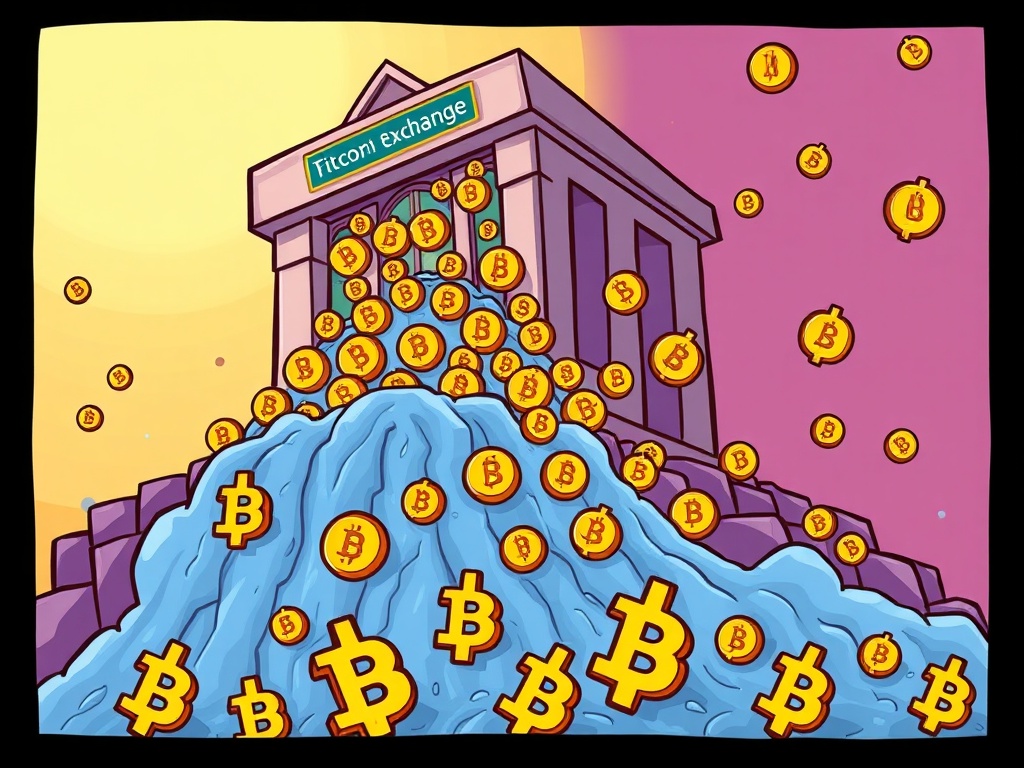BitcoinWorld

Urgent Alert: Binance BTC Inflows Surge, Hinting at Bitcoin Selling Pressure Ahead
The cryptocurrency market is a dynamic space, and understanding key indicators can provide valuable insights. Recently, a significant shift in Binance BTC inflows has caught the attention of analysts, potentially signaling upcoming changes in market dynamics. Let’s delve into what this means for investors and traders, leveraging recent on-chain data analysis.
What Do Surging Binance BTC Inflows Indicate?
On-chain data recently highlighted by CryptoQuant contributor CryptoOnchain reveals a sharp increase in Binance Exchange’s seven-day average Bitcoin (BTC) inflows. This means more Bitcoin is actively moving onto the platform. Such movements are crucial for market observers to track.
Historically, surges in exchange inflows have often been associated with several potential activities:
- Selling Preparation: Traders move BTC to exchanges to liquidate their holdings.
- Margin Collateralization: Funds are deposited to be used as collateral for leveraged trading positions.
- Institutional Portfolio Rebalancing: Large entities adjust their holdings, which can involve moving assets onto exchanges.
These actions can collectively contribute to an increase in the available supply of Bitcoin on the exchange, potentially impacting its price.
Decoding the Bitcoin Selling Pressure Signal
When Bitcoin flows onto exchanges, it increases the immediate supply. If buying demand does not match this increased supply, it typically leads to Bitcoin selling pressure in the short term. This imbalance can cause prices to decline.
The situation is further confirmed by a simultaneous rise in ‘positive netflow’ on Binance. Positive netflow signifies that the total BTC exchange balance on Binance is climbing. This growing liquidity on the exchange suggests a greater potential for assets to be sold, contributing to short-term crypto market volatility and possible downside.
Understanding this dynamic is vital for anticipating market movements. While inflows don’t guarantee a price drop, they certainly increase the likelihood if demand isn’t strong enough to absorb the incoming supply.
Navigating Potential Market Downside: Your Action Plan
Given the recent surge in Binance BTC inflows, what steps can market participants consider? It is always wise to approach such signals with a strategic mindset. Here are a few considerations:
- Monitor Demand: Keep a close eye on buying volume and order book depth. Strong buying demand can absorb increased supply.
- Risk Management: For traders, this might be a time to review stop-loss orders or consider reducing exposure if the market shows signs of weakness.
- Long-Term Perspective: For long-term investors, short-term fluctuations driven by inflows might present opportunities for accumulation if prices dip.
Remember, on-chain data provides insights, but it is just one piece of the puzzle. Combining it with other technical and fundamental analysis is key to making informed decisions in the volatile crypto space.
Summary: Stay Vigilant with On-Chain Data
The recent surge in Binance BTC inflows, coupled with positive netflow, is a notable development in the Bitcoin market. This on-chain data analysis from CryptoQuant indicates an increase in Bitcoin liquidity on the exchange, raising the potential for short-term Bitcoin selling pressure and increased crypto market volatility. While not a definitive forecast, it serves as an important signal for market participants to exercise caution and adjust their strategies accordingly. Staying informed about these underlying flows can empower you to navigate the market more effectively.
Frequently Asked Questions (FAQs)
Q1: What exactly are Binance BTC inflows?
A1: Binance BTC inflows refer to the amount of Bitcoin (BTC) that is transferred from external wallets or other exchanges into the Binance exchange’s wallets. An increase indicates more BTC is being made available on the platform.
Q2: Why do increased inflows often suggest selling pressure?
A2: When more Bitcoin moves onto an exchange, it typically means holders are preparing to sell, use it as collateral for trades, or rebalance portfolios. If buying demand doesn’t keep up with this increased supply, it can lead to downward price pressure.
Q3: What is ‘positive netflow’ and how does it relate?
A3: Positive netflow means that the total amount of a cryptocurrency on an exchange is increasing (inflows exceed outflows). In this context, it confirms that Binance’s overall BTC balance is growing, adding to the potential for sales.
Q4: How reliable is on-chain data analysis for predicting market movements?
A4: On-chain data provides valuable transparency into network activity and can offer strong insights into potential market trends. However, it’s not a sole predictor; it should be combined with other forms of analysis (technical, fundamental) for a comprehensive view.
Q5: Does this mean a guaranteed market crash for Bitcoin?
A5: No, increased inflows signal potential selling pressure, not a guaranteed crash. The actual market impact depends on various factors, including overall market sentiment, news events, and whether buying demand steps in to absorb the supply.
Q6: Where can I find more insights like this?
A6: Platforms like CryptoQuant, Glassnode, and other reputable on-chain analytics providers offer detailed data and analysis for market participants.
If you found this analysis helpful, please share it with your network! Understanding these crucial market signals helps everyone make more informed decisions in the crypto space. Your shares help us reach more people who need this vital information!
To learn more about the latest Bitcoin trends, explore our article on key developments shaping Bitcoin price action.
This post Urgent Alert: Binance BTC Inflows Surge, Hinting at Bitcoin Selling Pressure Ahead first appeared on BitcoinWorld and is written by Editorial Team





